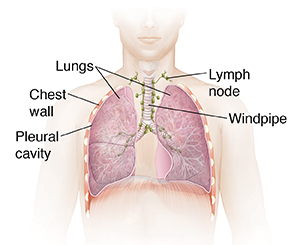Lung Surgery: Your Evaluation and Tests
Lung Surgery: Your Evaluation and Tests

You are having lung surgery. To evaluate your lungs and nearby areas, tests may be done. You may have had some of these tests. Others may be scheduled before your surgery. Your healthcare provider uses the information gathered during these tests to help plan your surgery and treatment.
Imaging tests
Imaging tests take pictures of your lungs. They can detect problems, such as a mass, an infection, or air in the space between the lungs and the chest wall (pleural cavity). But they can’t tell the healthcare provider for certain whether a lung mass is cancer. Imaging tests you may have include:
-
Chest X-rays
-
CT scans
-
MRI
-
PET (positron emission tomography) scans
-
Other imaging tests as needed
Tests that look at your lungs (or nearby areas) or take a tissue sample
You may need tests that look at the inside of your lungs and the area around them. Or you may need a test that takes small samples of lung cells or tissue (biopsy). The samples can be looked at later under a microscope. Possible tests include:
-
Bronchoscopy. This is done using a thin lighted tube called a bronchoscope. It is put in through your nose or mouth down to the lungs. It is used to look at breathing passages at the entrance to your lungs.
-
Mediastinoscopy. A tube is put through a cut (incision) above the breastbone. This tube is used to look at the area between the lungs.
-
Mediastinotomy. The lymph nodes in the chest are looked at through an incision in the chest wall. A biopsy may be done.
-
Needle biopsy. A needle is put through the chest wall or through a bronchoscope. The needle is used to collect tissue or fluid.
-
Endobronchial ultrasound. A bronchoscope is put down into the windpipe, and a tiny ultrasound device on the end is used to look at structures between the lungs. A needle can also be passed down the bronchoscope to take tissue samples if anything abnormal is seen.
Other tests
You may have tests to measure how well your lungs work. They include:
-
Pulmonary function tests. These measure how your lungs work. This includes testing how much air your lungs can hold and how much air is left in your lungs after you breathe out (exhale). These also measure how fast you can blow air out of your lungs.
-
Pulse oximetry. This measures how much oxygen is passed from your lungs to your blood.
-
Arterial blood samples. These show how much oxygen is in your blood.
Updated:
June 05, 2019
Sources:
Preoperative evaluation for lung resection. UpToDate
Reviewed By:
Gersten, Todd, MD,Stump-Sutliff, Kim, RN, MSN, AOCNS